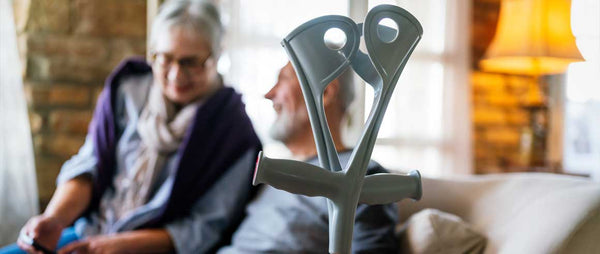What’s the largest cause of hospital admissions for older people? You might guess that it’s the latest winter flu bug. But you’d be wrong - it’s a more everyday problem.
Nearly a quarter of a million older people go to hospitals in England every year after falling. Even when bones aren’t broken, trips and tumbles can damage someone’s confidence, mental wellbeing and independence.
They’re a major cause of people moving from their own home to long-term nursing or residential care. Control and prevention of falls can make a big difference to someone's independence.
Conduct your own risk assessment and be aware of slip hazards. Pay attention to trip hazards, clean up spills and wet flooring are simple preventative measures.
Calculate your loved one's risk score
Complete our 2 minute questionnaire to receive personalised care recommendations based on an assessment of your loved one's circumstances.
Get your risk score
Helping the elderly stay steady on their feet
As many as 30% of people aged 65 and 50% of people aged over 80 take a fall every year, costing the NHS a whopping £2.3 billion a year. As is often the case, nearly everyone underestimates the risks of this happening to us (or a loved one). That’s not a big issue if you’re able to bounce back. But if you’re older, disabled or less mobile, it’s yet another worry.
Many older people with mobility issues assume that there’s not much they can do to prevent falls. But despite their fears, falls don’t need to be an inevitable part of growing older.
You can do things to keep your parents and older relatives safer, such as re-organising their home. And if accidents do happen, there are products and services you can choose to help minimise the harm - such as fall detectors and elderly fall alarms.
Everyone has different needs. So if you’re helping to support an elderly relative, it pays to spend some time observing. Watch them moving around the house, and put yourself in their shoes:
- What things are they doing that might make them feel unsteady?
- Where does this happen, and at what times of day?
- For example, many older people are vulnerable at night during a trip to the loo. Fitting a light switch close by and keeping the hallway well-lit might make all the difference.
- Good lighting is important full stop - when it’s difficult to see, it’s easy to become disorientated or stumble. And if your loved one’s eye test is overdue, get one in the diary.
About 30% of visual impairment in people over 75 comes from wearing the wrong glasses (or none at all). Even if we’re lucky enough to have good eyesight, age isn’t on our side. If you’re 60 now, your eyes need at least three times the light to work as well as they did when you were 20!
No wonder many older folk struggle to see the edges on stairs and pavements when they look down.
Download Fall Prevention Guide
Prevent falls by remaining active
Balance problems and muscle weakness also causes falls. If it’s appropriate, encourage your loved one to improve their strength by joining exercise classes or other physical activities.
The good news is even simple activities such as walking can help older adults stay active and improve strength and balance.
We know this works - one study shows that a tailored exercise programme can reduce the risk of falling by up to 50%. Exercise is great for mental health and confidence, too. Where a bit of help is needed, make sure there are banisters or handrails where needed, and non-slip mats and grab bars in the bathroom.
Fall detectors, sensors and alarms
If a fall does happen, a personal fall alarm can be a real lifesaver. Signalling for help quickly can stop an accident turning into an emergency - especially in winter when homes and gardens can become very cold. The detector is worn like a necklace or a watch, and automatically triggers an alert to a monitoring team if the wearer has taken a tumble.
One of the best things about fall detectors is that they’re automatic. They send an alert – day or night - without the wearer having to do anything themselves. No-one needs to worry about mastering a mobile phone, or keeping it nearby, or fiddly touchscreens.
If the fall detector sends an alert, an Emergency Resolution team will pick this up straightaway and take the appropriate action. So it provides help and reassurance when it’s needed the most. With different sensitivity settings, false alarms are rare – and, if there is one, the wearer has time to cancel it.
Download Fall Prevention Guide
TakingCare offer a range of different alarm products with various features that are suited to lots of different types of lifestyle and personal preference. We believe that we have a personal alarm to suit everyone. Get in touch with our team by calling 0800 0121 321 if you want some help choosing the right personal alarm product for your elderly loved one. You can also view our full range of alarms here.
You may also be interested in...
- Val's experience of getting a fall alarm
- What to do for bruising after a fall
- More tips to prevent falls at home
- Mechanical lifting tools to help you life someone after a fall
- Elderly fall alarms
Sources




